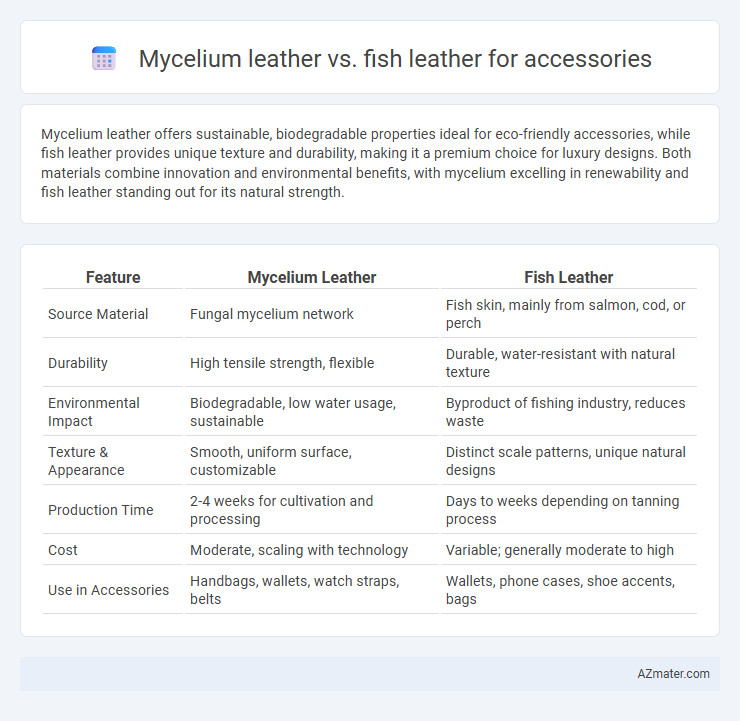Mycelium leather offers sustainable, biodegradable properties ideal for eco-friendly accessories, while fish leather provides unique texture and durability, making it a premium choice for luxury designs. Both materials combine innovation and environmental benefits, with mycelium excelling in renewability and fish leather standing out for its natural strength.
Table of Comparison
| Feature | Mycelium Leather | Fish Leather |
|---|---|---|
| Source Material | Fungal mycelium network | Fish skin, mainly from salmon, cod, or perch |
| Durability | High tensile strength, flexible | Durable, water-resistant with natural texture |
| Environmental Impact | Biodegradable, low water usage, sustainable | Byproduct of fishing industry, reduces waste |
| Texture & Appearance | Smooth, uniform surface, customizable | Distinct scale patterns, unique natural designs |
| Production Time | 2-4 weeks for cultivation and processing | Days to weeks depending on tanning process |
| Cost | Moderate, scaling with technology | Variable; generally moderate to high |
| Use in Accessories | Handbags, wallets, watch straps, belts | Wallets, phone cases, shoe accents, bags |
Introduction to Alternative Leathers
Mycelium leather, derived from fungal roots, offers a sustainable and biodegradable alternative to traditional animal hides, while fish leather repurposes durable and textured skins from fish species like salmon and perch. Both materials provide eco-friendly solutions in the accessory market, reducing reliance on cattle leather and minimizing environmental impact. Innovations in processing techniques enhance the durability and aesthetic appeal of mycelium and fish leathers, making them increasingly popular for fashion accessories such as bags, wallets, and watch straps.
What is Mycelium Leather?
Mycelium leather is produced from the root structure of mushrooms, known as mycelium, offering a sustainable and biodegradable alternative to traditional animal leather. This innovative material combines natural fibers and bio-fabrication technology, resulting in a durable yet flexible texture ideal for accessories like wallets, bags, and shoes. Unlike fish leather, which uses tanned fish skin and emphasizes toughness and unique grain patterns, mycelium leather stands out for its eco-friendly production and customizable design properties.
What is Fish Leather?
Fish leather, derived from the skins of various fish species such as salmon, perch, and carp, is a sustainable and durable material known for its unique texture and strength. Compared to mycelium leather, fish leather offers a natural grain pattern and high resistance to wear, making it ideal for luxury accessories like wallets and watch straps. Its eco-friendly appeal stems from utilizing byproducts of the fishing industry, reducing waste while providing an alternative to traditional animal leathers.
Sustainability Comparison
Mycelium leather and fish leather both offer sustainable alternatives to traditional animal leather, with mycelium leather produced from fungal roots using minimal water and no toxic chemicals, resulting in a lower carbon footprint compared to fish leather derived from fish skin, which repurposes existing byproducts but still involves more intensive processing. Mycelium leather is biodegradable and rapidly renewable, while fish leather contributes to waste reduction by utilizing fishery leftovers, enhancing circular economy practices. Both materials reduce reliance on livestock, but mycelium leather generally presents a more scalable and environmentally friendly solution for accessory manufacturing.
Durability and Performance
Mycelium leather offers remarkable durability with a high resistance to wear and tear, making it suitable for everyday accessories that demand longevity and flexibility. Fish leather boasts exceptional tensile strength and natural water resistance, lending unique toughness and an attractive texture for high-performance accessories. Both materials excel in sustainability, but fish leather traditionally outperforms mycelium in terms of tensile strength, while mycelium excels in lightweight flexibility.
Aesthetics and Texture
Mycelium leather offers a smooth, matte finish with a uniform texture that mimics traditional animal leather while providing a modern, eco-friendly appeal. Fish leather exhibits a distinctive scale pattern and natural grain, delivering a unique, tactile surface prized for its exotic and luxurious aesthetic. Both materials enhance accessories with durability and visual interest, but fish leather stands out for its textured complexity, whereas mycelium leather excels in versatility and consistent appearance.
Production Processes
Mycelium leather production involves cultivating fungal mycelium on agricultural waste, requiring controlled humidity and temperature to develop a durable, sustainable material with minimal environmental impact. Fish leather is produced by tanning fish skin, typically from species like salmon or cod, using chemical tanning agents and natural oils to ensure flexibility and water resistance. Both materials offer eco-friendly alternatives to traditional leather, but Mycelium leather emphasizes rapid growth cycles and waste reduction, while fish leather relies on repurposing byproducts from the fishing industry.
Environmental Impact
Mycelium leather offers a significantly lower environmental impact than fish leather by utilizing fast-growing fungal biomass that requires minimal water, land, and chemicals, promoting sustainable production. Fish leather, while repurposing fish skins and reducing waste, involves intensive tanning processes that often use toxic substances harmful to ecosystems. Choosing mycelium leather supports circular economy principles and reduces carbon footprints compared to the resource-intensive and pollutant-heavy processing of fish leather.
Applications in Accessories
Mycelium leather offers a sustainable and vegan alternative in accessories such as wallets, bags, and watch straps, providing durability and a natural texture that mimics traditional leather. Fish leather, derived from durable fish skins like salmon and carp, is prized for its unique scale patterns and moisture resistance, making it ideal for high-end wallets, belts, and footwear accents. Both materials cater to eco-conscious consumers seeking innovative, cruelty-free options with distinct aesthetic qualities in the accessory market.
Future Trends and Market Potential
Mycelium leather and fish leather represent innovative, sustainable alternatives to traditional materials in the accessory market, driven by increasing consumer demand for eco-friendly products. Mycelium leather, derived from fungal roots, offers rapid biodegradability and customizable textures, while fish leather, made from discarded fish skins, provides unique durability and distinctive patterns. Market projections highlight significant growth for these materials, fueled by advancements in biotechnology and rising interest in circular fashion, positioning both as key players in the future of sustainable accessories.

Infographic: Mycelium leather vs Fish leather for Accessory
 azmater.com
azmater.com